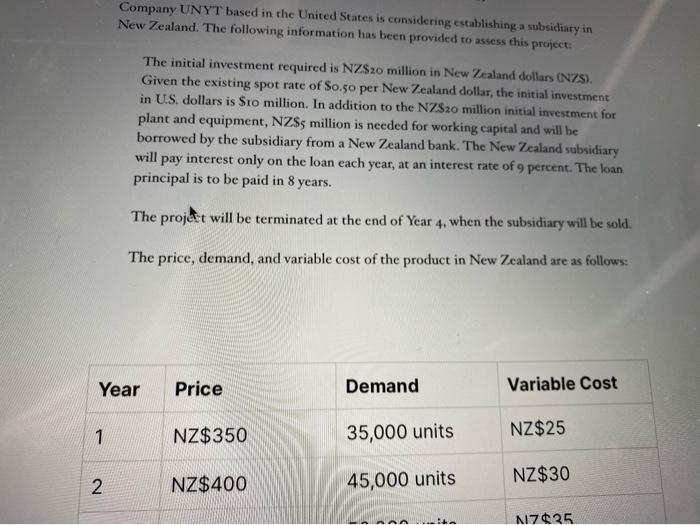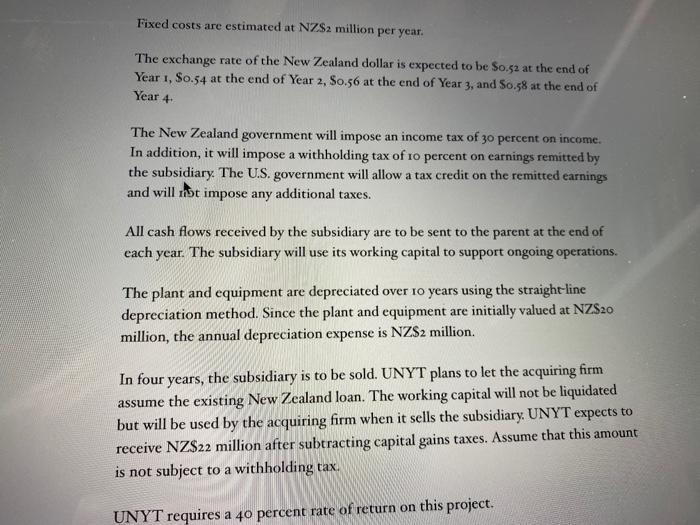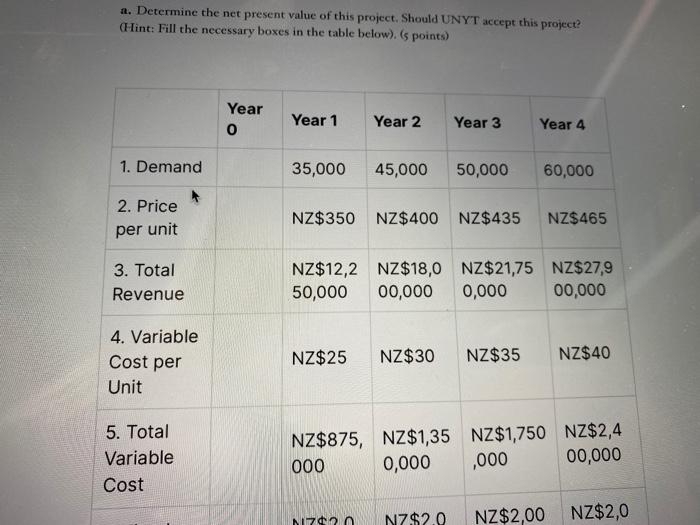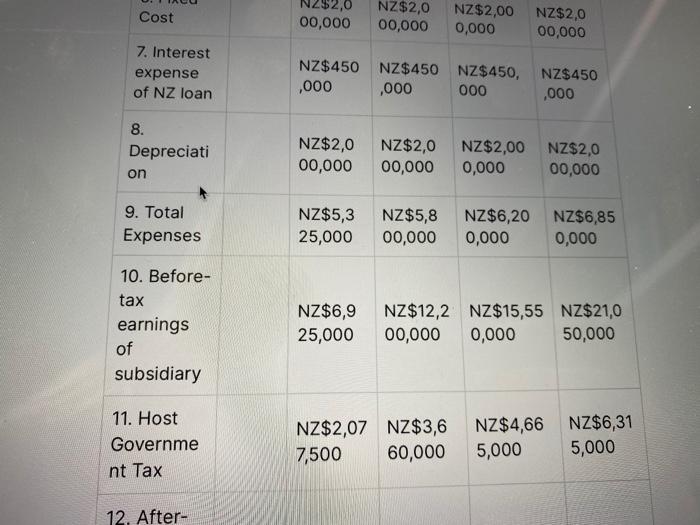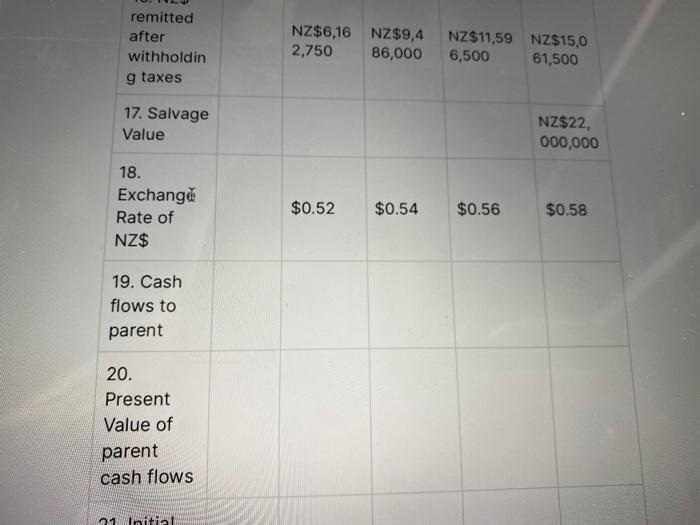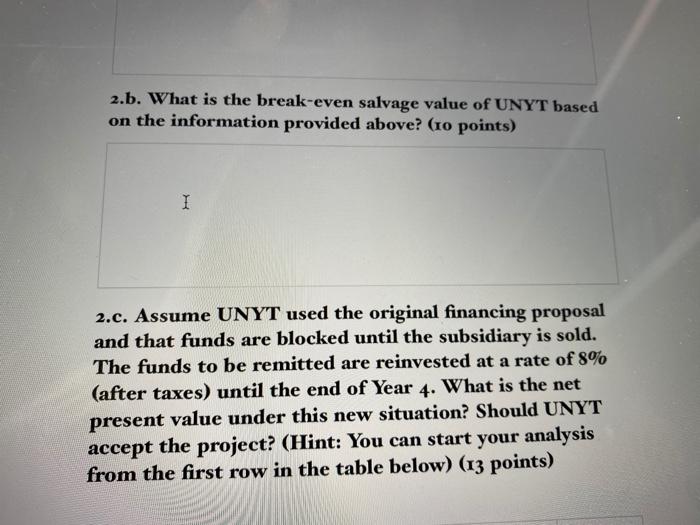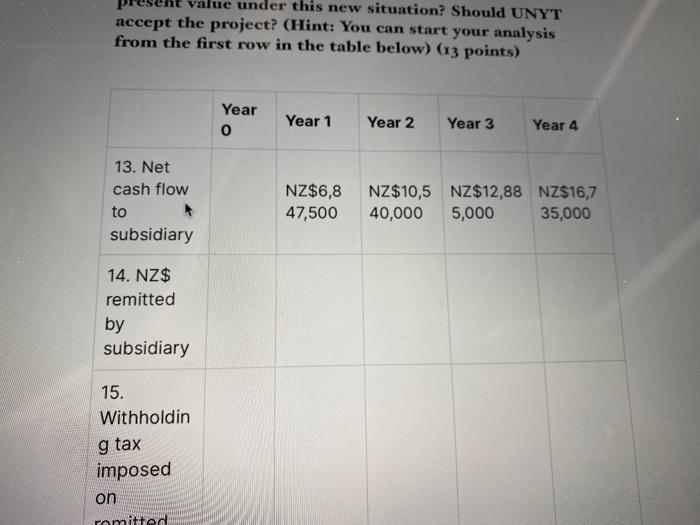Company UNYT based in the United States is considering establishing a subsidiary in New Zealand. The following information has been provided to assess this project: The initial investment required is NZ$20 million in New Zealand dollars (NZS). Given the existing spot rate of So.50 per New Zealand dollar, the initial investment in US dollars is Sto million. In addition to the NZ$20 million initial investment for plant and equipment, NZ$5 million is needed for working capital and will be borrowed by the subsidiary from a New Zealand bank. The New Zealand subsidiary will pay interest only on the loan each year, at an interest rate of 9 percent. The loan principal is to be paid in 8 years. The project will be terminated at the end of Year 4, when the subsidiary will be sold. The price, demand, and variable cost of the product in New Zealand are as follows: Year Price Demand Variable Cost 1 NZ$350 35,000 units NZ$25 2 NZ$30 NZ$400 45,000 units N17025 Zealand subsidiary will pay interest only on the loan each year, at an interest rate of 9 percent. The loan principal is to be paid in 8 years. The project will be terminated at the end of Year 4, when the subsidiary will be sold. The price, demand, and variable cost of the product in New Zealand are as follows: Year Price Demand Variable Cost 1 NZ$350 35,000 units NZ$25 2 NZ$400 45,000 units NZ$30 3 NZ$435 50,000 units NZ$35 4 NZ$465 60,000 units NZ$40 Hanner year Fixed costs are estimated at NZ$2 million per year. The exchange rate of the New Zealand dollar is expected to be $0.52 at the end of Year 1, $0.54 at the end of Year 2, 80,56 at the end of Year 3, and 50.58 at the end of Year 4: The New Zealand government will impose an income tax of 30 percent on income. In addition, it will impose a withholding tax of 10 percent on earnings remitted by the subsidiary. The U.S. government will allow a tax credit on the remitted earnings and will not impose any additional taxes. All cash flows received by the subsidiary are to be sent to the parent at the end of each year. The subsidiary will use its working capital to support ongoing operations. The plant and equipment are depreciated over to years using the straight-line depreciation method. Since the plant and equipment are initially valued at NZ$20 million, the annual depreciation expense is NZ$2 million. In four years, the subsidiary is to be sold. UNYT plans to let the acquiring firm assume the existing New Zealand loan. The working capital will not be liquidated but will be used by the acquiring firm when it sells the subsidiary. UNYT expects to receive NZ$22 million after subtracting capital gains taxes. Assume that this amount is not subject to a withholding tax. UNYT requires a 40 percent rate of return on this project. a. Determine the net present value of this project. Should UNYT accept this project? (Hint: Fill the necessary boxes in the table below). (s points) Year 0 Year 1 Year 2 Year 3 Year 4 1. Demand 35,000 45,000 50,000 60,000 2. Price NZ$350 NZ$400 NZ$435 NZ$465 per unit 3. Total Revenue NZ$12,2 50,000 NZ$18,0 NZ$21,75 00,000 0,000 NZ$27,9 00,000 4. Variable Cost per Unit NZ$25 NZ$30 NZ$35 NZ$40 5. Total Variable Cost NZ$875, NZ$1,35 NZ$1,750 NZ$2,4 000 0,000 ,000 00,000 N7020 NZ$2.0 NZ$2,00 NZ$2,0 Cost 2$2,0 00,000 NZ$2,0 00,000 NZ$2,00 0,000 NZ$2,0 00,000 7. Interest expense of NZ loan NZ$450 ,000 NZ$450 NZ$450, ,000 000 NZ$450 ,000 8. Depreciati on NZ$2,0 00,000 NZ$2,0 00,000 NZ$2,00 0,000 NZ$2,0 00,000 9. Total Expenses NZ$5,3 25,000 NZ$5,8 00,000 NZ$6,20 0,000 NZ$6,85 0,000 10. Before- tax earnings of subsidiary NZ$6,9 25,000 NZ$12,2 NZ$15,55 NZ$21,0 00,000 0,000 50,000 11. Host Governme nt Tax NZ$2,07 NZ$3,6 7,500 60,000 NZ$4,66 5,000 NZ$6,31 5,000 12. After- nt Tax 7,500 60,000 5,000 5,000 12. After- tax earnings of subsidiary NZ$4,8 47,500 NZ$8,5 40,000 NZ$10,88 NZ$14,7 5,000 35,000 13. Net cash flow to subsidiary NZ$6,8 47,500 NZ$10,5 NZ$12,88 NZ$16,7 40,000 5,000 35,000 14. NZ$ remitted by subsidiary NZ$6,8 47,500 NZ$10,5 NZ$12,88 NZ$16,7 40,000 5,000 35,000 15. Withholdin g tax imposed on NZ$684 NZ$1,05 NZ$1,288 NZ$1,67 ,750 4,000 ,500 3,500 remitted after withholdin g taxes NZ$6,16 NZ$9,4 2,750 86,000 NZ$11,59 NZ$15,0 6,500 61,500 17. Salvage Value NZ$22, 000,000 18. Exchange Rate of NZ$ $0.52 $0.54 $0.56 $0.58 19. Cash flows to parent 20. Present Value of parent cash flows 1 Initial $0.52 $0.54 $0.56 Rate of NZ$ $0.58 19. Cash flows to parent 20. Present Value of parent cash flows 21. Initial Investmen t 22. Cumulativ e NPV of cash flows 2.b. What is the break-even salvage value of UNYT based on the information provided above? (10 points) I 2.c. Assume UNYT used the original financing proposal and that funds are blocked until the subsidiary is sold. The funds to be remitted are reinvested at a rate of 8% (after taxes) until the end of Year 4. What is the net present value under this new situation? Should UNYT accept the project? (Hint: You can start your analysis from the first row in the table below) (13 points) value under this new situation? Should UNYT accept the project? (Hint: You can start your analysis from the first row in the table below) (13 points) Year o Year 1 Year 2 Year 3 Year 4 13. Net cash flow to subsidiary NZ$6,8 47,500 NZ$10,5 NZ$12,88 NZ$16,7 40,000 5,000 35,000 14. NZ$ remitted by subsidiary 15. Withholdin g tax imposed on romitted Company UNYT based in the United States is considering establishing a subsidiary in New Zealand. The following information has been provided to assess this project: The initial investment required is NZ$20 million in New Zealand dollars (NZS). Given the existing spot rate of So.50 per New Zealand dollar, the initial investment in US dollars is Sto million. In addition to the NZ$20 million initial investment for plant and equipment, NZ$5 million is needed for working capital and will be borrowed by the subsidiary from a New Zealand bank. The New Zealand subsidiary will pay interest only on the loan each year, at an interest rate of 9 percent. The loan principal is to be paid in 8 years. The project will be terminated at the end of Year 4, when the subsidiary will be sold. The price, demand, and variable cost of the product in New Zealand are as follows: Year Price Demand Variable Cost 1 NZ$350 35,000 units NZ$25 2 NZ$30 NZ$400 45,000 units N17025 Zealand subsidiary will pay interest only on the loan each year, at an interest rate of 9 percent. The loan principal is to be paid in 8 years. The project will be terminated at the end of Year 4, when the subsidiary will be sold. The price, demand, and variable cost of the product in New Zealand are as follows: Year Price Demand Variable Cost 1 NZ$350 35,000 units NZ$25 2 NZ$400 45,000 units NZ$30 3 NZ$435 50,000 units NZ$35 4 NZ$465 60,000 units NZ$40 Hanner year Fixed costs are estimated at NZ$2 million per year. The exchange rate of the New Zealand dollar is expected to be $0.52 at the end of Year 1, $0.54 at the end of Year 2, 80,56 at the end of Year 3, and 50.58 at the end of Year 4: The New Zealand government will impose an income tax of 30 percent on income. In addition, it will impose a withholding tax of 10 percent on earnings remitted by the subsidiary. The U.S. government will allow a tax credit on the remitted earnings and will not impose any additional taxes. All cash flows received by the subsidiary are to be sent to the parent at the end of each year. The subsidiary will use its working capital to support ongoing operations. The plant and equipment are depreciated over to years using the straight-line depreciation method. Since the plant and equipment are initially valued at NZ$20 million, the annual depreciation expense is NZ$2 million. In four years, the subsidiary is to be sold. UNYT plans to let the acquiring firm assume the existing New Zealand loan. The working capital will not be liquidated but will be used by the acquiring firm when it sells the subsidiary. UNYT expects to receive NZ$22 million after subtracting capital gains taxes. Assume that this amount is not subject to a withholding tax. UNYT requires a 40 percent rate of return on this project. a. Determine the net present value of this project. Should UNYT accept this project? (Hint: Fill the necessary boxes in the table below). (s points) Year 0 Year 1 Year 2 Year 3 Year 4 1. Demand 35,000 45,000 50,000 60,000 2. Price NZ$350 NZ$400 NZ$435 NZ$465 per unit 3. Total Revenue NZ$12,2 50,000 NZ$18,0 NZ$21,75 00,000 0,000 NZ$27,9 00,000 4. Variable Cost per Unit NZ$25 NZ$30 NZ$35 NZ$40 5. Total Variable Cost NZ$875, NZ$1,35 NZ$1,750 NZ$2,4 000 0,000 ,000 00,000 N7020 NZ$2.0 NZ$2,00 NZ$2,0 Cost 2$2,0 00,000 NZ$2,0 00,000 NZ$2,00 0,000 NZ$2,0 00,000 7. Interest expense of NZ loan NZ$450 ,000 NZ$450 NZ$450, ,000 000 NZ$450 ,000 8. Depreciati on NZ$2,0 00,000 NZ$2,0 00,000 NZ$2,00 0,000 NZ$2,0 00,000 9. Total Expenses NZ$5,3 25,000 NZ$5,8 00,000 NZ$6,20 0,000 NZ$6,85 0,000 10. Before- tax earnings of subsidiary NZ$6,9 25,000 NZ$12,2 NZ$15,55 NZ$21,0 00,000 0,000 50,000 11. Host Governme nt Tax NZ$2,07 NZ$3,6 7,500 60,000 NZ$4,66 5,000 NZ$6,31 5,000 12. After- nt Tax 7,500 60,000 5,000 5,000 12. After- tax earnings of subsidiary NZ$4,8 47,500 NZ$8,5 40,000 NZ$10,88 NZ$14,7 5,000 35,000 13. Net cash flow to subsidiary NZ$6,8 47,500 NZ$10,5 NZ$12,88 NZ$16,7 40,000 5,000 35,000 14. NZ$ remitted by subsidiary NZ$6,8 47,500 NZ$10,5 NZ$12,88 NZ$16,7 40,000 5,000 35,000 15. Withholdin g tax imposed on NZ$684 NZ$1,05 NZ$1,288 NZ$1,67 ,750 4,000 ,500 3,500 remitted after withholdin g taxes NZ$6,16 NZ$9,4 2,750 86,000 NZ$11,59 NZ$15,0 6,500 61,500 17. Salvage Value NZ$22, 000,000 18. Exchange Rate of NZ$ $0.52 $0.54 $0.56 $0.58 19. Cash flows to parent 20. Present Value of parent cash flows 1 Initial $0.52 $0.54 $0.56 Rate of NZ$ $0.58 19. Cash flows to parent 20. Present Value of parent cash flows 21. Initial Investmen t 22. Cumulativ e NPV of cash flows 2.b. What is the break-even salvage value of UNYT based on the information provided above? (10 points) I 2.c. Assume UNYT used the original financing proposal and that funds are blocked until the subsidiary is sold. The funds to be remitted are reinvested at a rate of 8% (after taxes) until the end of Year 4. What is the net present value under this new situation? Should UNYT accept the project? (Hint: You can start your analysis from the first row in the table below) (13 points) value under this new situation? Should UNYT accept the project? (Hint: You can start your analysis from the first row in the table below) (13 points) Year o Year 1 Year 2 Year 3 Year 4 13. Net cash flow to subsidiary NZ$6,8 47,500 NZ$10,5 NZ$12,88 NZ$16,7 40,000 5,000 35,000 14. NZ$ remitted by subsidiary 15. Withholdin g tax imposed on romitted
